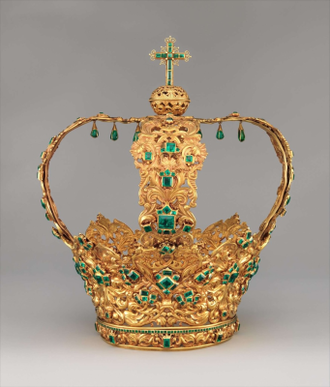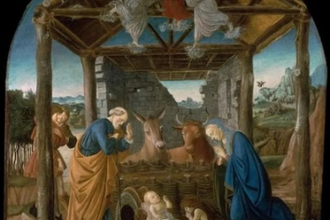Gospel in Art: The Immaculate Conception of the Blessed Virgin Mary

'The Crown of the Andes', Colombia, Popayán 1660 (diadem) 1770 (arches) © The Metropolitan Museum, New York
Source: Christian Art
9 December 2024
Luke 1:26-38
At that time: The angel Gabriel was sent from God to a city of Galilee named Nazareth, to a virgin betrothed to a man whose name was Joseph, of the house of David. And the virgin's name was Mary. And he came to her and said, 'Hail, full of grace, the Lord is with you!' But she was greatly troubled at the saying, and tried to discern what sort of greeting this might be. And the angel said to her, 'Do not be afraid, Mary, for you have found favour with God. And behold, you will conceive in your womb and bear a son, and you shall call his name Jesus. He will be great and will be called the Son of the Most High. And the Lord God will give to him the throne of his father David, and he will reign over the house of Jacob for ever, and of his kingdom there will be no end.'
And Mary said to the angel, 'How will this be, since I am a virgin?' And the angel answered her, 'The Holy Spirit will come upon you, and the power of the Most High will overshadow you; therefore the child to be born will be called holy - the Son of God. And behold, your relative Elizabeth in her old age has also conceived a son, and this is the sixth month with her who was called barren. For nothing will be impossible with God.' And Mary said, 'Behold, I am the servant of the Lord; let it be to me according to your word.' And the angel departed from her.
Reflection on the Crown
Today we celebrate the Feast of the Immaculate Conception of the Virgin Mary. Normally this feast gets celebrated on 8 December. The 8th was the Second Sunday of Advent, and so has liturgical preference over the Immaculate Conception. Hence, the observance of the Solemnity was moved this year to today.
The Immaculate Conception refers to the dogma that the Blessed Virgin Mary was conceived without any stain of original sin in preparation for becoming the Mother of God, her Son Jesus Christ. In 1854, Pope Pius IX's solemn declaration, "Ineffabilis Deus,"clarified with finality the long-held belief of the Church that Mary was conceived free from original sin. Mary was granted this extraordinary privilege because of her unique role in the history of Salvation. This divine grace prepared her to be the perfect and spotless tabernacle to carry and nurture Jesus Christ in her womb. Just as the tabernacle in a church holds the Eucharist, the living presence of Christ, Mary's womb was sanctified to be a pure and holy dwelling place for the Incarnation.
When the Spaniards arrived in 16th-century South America, they encountered a rich and thriving indigenous tradition of gold working that had developed over the course of millennia. Unfortunately, many, if not most, pre-Columbian works in gold were melted down in the 16th & 17th centuries; their precious metal was, however, repurposed for new religious and secular leaders both in Spain and the Americas.
Our crown was made to adorn a sacred image of the Virgin Mary venerated in the cathedral of Popayán (Colombia). The crown is a symbol of the Virgin's divine queenship. The gold crown is decorated with vine motifs (referring to the eucharistic sacrifice of her son) set with emerald clusters in the shape of flowers, a reference to her purity. The diadem is topped by imperial arches and a cross-bearing orb that symbolises Christ's dominion over the world. It has been common practice around the world to bestow lavish gifts, including jewels and sumptuous garments, on sculptures of the Virgin Mary. The Christian faithful have always sought to honour the Virgin Mary through beautiful works of art as a profound expression of devotion and reverence.
LINKS
Gospel in Art: https://christian.art/
Today's Reflection: https://christian.art/daily-gospel-reading/luke-1-26-38-2024-3/


















